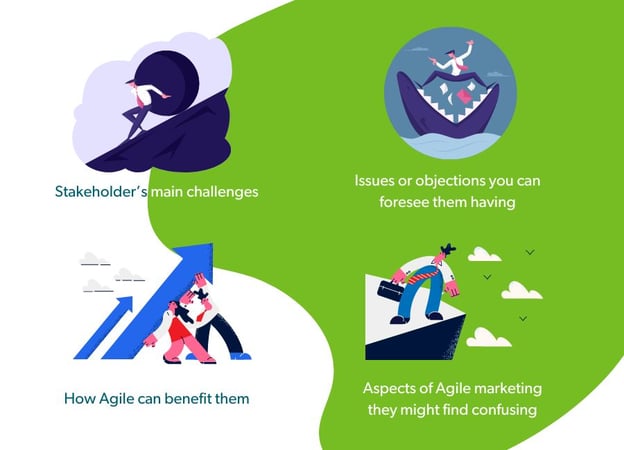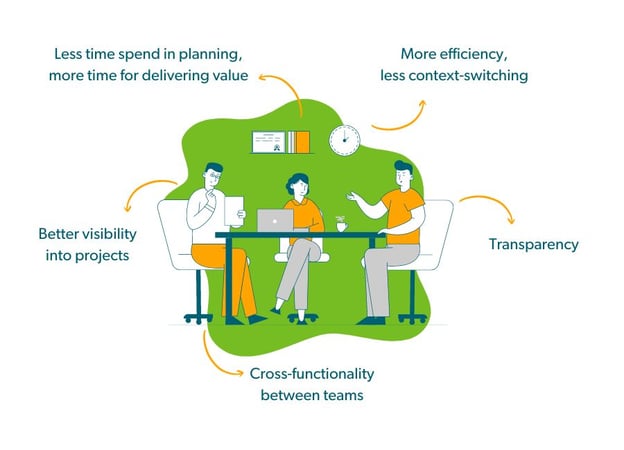Improve your Marketing Ops every week
Subscribe to our blog to get insights sent directly to your inbox.
Confront your process problems head on with a Sherpa by your side.
Explore support options that are tailored to meet you wherever you are on your climb.
Browse our pioneering Agile marketing courses
Learn from the stories of marketers already on the road to process improvement.
Featured Resource

State of Agile Marketing
Learn from 8 years of study on how marketers are increasing their agility.
Download Report
From the outside looking in, Agile marketing can be confusing, or even downright intimidating. Yet getting understanding from non-Agile stakeholders is critical for success.
Whether or not they go Agile themselves (which is always great, as Agile marketers prefer to work with other Agile teams), they need to understand why you’re working the way you are and what they can expect from your Agile marketing process.
So how do you explain Agile to them and ensure you can work together effectively?
As long-standing Agile marketers who’ve worked with plenty of non-Agile stakeholders, we’re breaking down our experience into practical tips for you.
Before you jump into a monologue about the power of Agile marketing, take a moment to consider who you’re speaking to.
The way you frame and define Agile marketing and its benefits has to be tailored to the specific needs of your stakeholders. They’re far less likely to embrace Agile if they feel like you’re giving them a canned speech instead of actually talking to them.

So consider:
Starting by answering these questions ensures the way you define and explain Agile marketing will get ahead of potential problems, questions, or objections. This should also reduce the need for a lot of back and forth so you and your stakeholder can get back to what’s important.
When defining Agile for a non-Agile stakeholder it’s critical you answer this question for them: what’s in it for me?

Stakeholders aren’t likely to jump at the chance to engage with a new way of working if the value that system brings to them isn’t clear. It can be useful to practice this as a kind of elevator pitch so you’re comfortable running through the basics quickly, clearly, and efficiently whenever you get a chance.
Here are some of the core benefits you can focus on:
As you’re doing this, be sure to lean towards using common, understandable language instead of getting bogged down in Agile jargon. This would otherwise require you to stop and spend time explaining niche terms, slowing down the process, and making Agile as a whole feel more foreign and abstract.
Remember, Agile should be about the value you’re going to provide the stakeholder.
A long list of new terms to study like a homework assignment just doesn’t fit that mission.
After all, if you’re trying to explain how Agile will enhance transparency and communication while bombarding someone with strange jargon, you’re fatally undermining your own message.
If you need help, you can find handy guides explaining key Agile terms online.
Before proceeding to learn the next tip, why don't you take a second to get our Agile Marketing Transformation Checklist?
Fortunately, when explaining the value of Agile you can always rely on the simple fact that delivering stakeholder value is the key metric of the entire approach. So instead of framing Agile as just another way of working, you can frame it as a way of working that puts them at its center.
Remember, at this point you should already have a sense of what “value” means to your stakeholders. So you can focus your explanation of Agile on demonstrating how it’s going to help them achieve whatever their key metrics are.
The flip side is that if Agile is inherently iterative. So even if you hit a bump along the way and fail to provide them the value they need, iteration is built-in. That brings us to another key element to emphasize.
Agile should seem far less intimidating when it’s clear that it’s not a rigid, top-down kind of system.
Make it clear that it’s okay to do Agile a bit differently and that adjusting it to meet your unique needs is a key part of the process. This enables you to get ahead of any issues which might arise early on by making it clear they are to be expected.

A key part of this is explaining that Agile is a mindset, not a set of exact practices.
In other words, Agile isn’t standups and boards, it’s values and principles. So the practices can and will evolve as long as they continue to focus on those values and principles.
Beyond just explaining all of this, it’s tremendously helpful to show it in action. Invite your non-Agile stakeholders to attend reviews and retros to see Agile in action. Just be sure to give some thought as to which stakeholders need to attend which meetings. Fortunately, there are guides to help you do that.
Again, turning Agile from something abstract into something concrete helps make it seem less intimidating from the outside.
Despite all of the techniques outlined above, all of this talk of values and principles can still feel somewhat abstract. In some cases, stakeholders might feel that seeing some concrete data on what Agile is and what it can accomplish will help them wrap their heads around it.
For marketing, look no further than the 7th annual State of Agile Marketing Report. For Agile as a whole, you can refer to the 15th State of Agile Report. Both contain data compiled from hundreds of real Agile practitioners and can help you explain the challenges and benefits of Agile based on real-world experiences.
If you’re lucky, you might even convince them to try Agile for themselves.
From explaining Agile to executing it well enough to unlock the full potential of business agility, the right training makes all the difference. That kind of training comes from experienced Agile practitioners who have been on both ends, teaching and explaining Agile as well as executing it in the real world.
So consider trying a self-paced introduction to business agility course specifically designed for non-technical teams to help you achieve your full Agile potential.
Before you move on, don't forget to get your copy of the Agile Marketing Transformation Checklist.
Subscribe to our blog to get insights sent directly to your inbox.
Subscribe to our blog to get insights sent directly to your inbox.